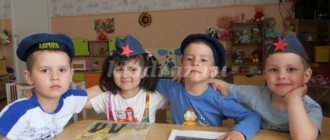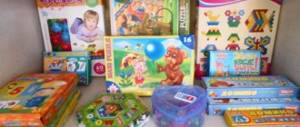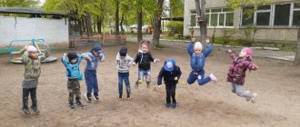Stages of organizing classes
Preparation for the game should include familiarizing children with the topic, basic rules and the result of the activity.
Note! It is important to prepare in advance additional materials that may be required during the process (balls, balls, sticks, ribbons for blindfolding, etc.).
You can motivate children to play by telling them fairy tales, asking them to solve riddles, or watching pictures/short videos showing the game process.
According to the Federal State Educational Standard, the duration of outdoor games in the senior group should not exceed 20 minutes. You should make a plan in advance (three months in advance). An example of a children's activity plan for three winter months:
- December 15 – game “Snowballs”. The goal is to develop the eye, accuracy and strength. The lesson is conducted on a walk. A circle is drawn on a sheet of plywood, into which children must hit it with a snowball from a certain distance, having previously molded it.
- January 15 – game “Ball for the Driver”. Two lines are drawn. On one, the players stand in a column, on the other, on the contrary, there is a driver who throws the ball to the first participant. He catches him, throws him back and stands at the end of the group. The game continues until the last player throws the ball to the driver.
- February 15 – game “One, two, three...”. Children energetically walk around the hall in a chaotic manner. When the teacher calls one of the numbers (1, 2, 3), the kids should stand up individually, in pairs or in threes, respectively, as quickly as possible.
Note! Control of outdoor games is carried out by analyzing the active activities of preschoolers, recorded in special forms and report sheets.
Active activity in the hall
Methodology and organization of classes
Outdoor games in the senior group are very diverse and depend on the location of the lesson, the time of year, and the period of study based on materials from the kindergarten program.
You should choose them for an individual or group lesson based on:
- child's age;
- goals set by the teacher;
- venue;
- interest of children;
- time of year.
Organization of the game consists of several stages:
- Arousing interest in the game. To achieve this goal, plot readings of suitable literature, study of songs, and familiarization with the attributes of the event are carried out in advance.
- Organization of the game and explanation of the rules. When getting acquainted with the exercise, the procedure is explained from beginning to end. If a repetition occurs, the teacher asks the children to remember the rules.
- Control of mobile activity. An adult monitors the child’s well-being throughout the game, prevents rule violations, and encourages and praises those participating.
- Summarizing. It is imperative to discuss the results of competitions with children, identify mistakes, praise them for achievements, and explain in a gentle manner the reason for failure.
Important! You should not insist on your child’s participation in the game if he shows persistent reluctance. The baby should enjoy doing the exercises, and not do everything forcibly.
Running in kindergarten
Card index
Examples of games that can be played outside.
| Name | Description |
| "Classics" | Held in summer. A classic field, familiar to everyone from childhood, is drawn with chalk on the asphalt. The teacher shows how it needs to be overcome. There are many options: on two legs, alternately, using a pebble, only back and forth, back and forth, etc. There is also “Hopscotch” in the shape of a square (3x3), the meaning of the game is similar. |
| "Blind Man's Bluff" | The presenter is blindfolded, twisted a little and scatter in different directions. His task is to find other players who can tell their location by clapping their hands. The first person the leader touches takes his place. |
| "Higher than your feet off the ground" | A game for walking in the summer months. The driver must catch the other players, following one rule - you cannot touch anyone standing on a hill. It is forbidden to stay in the “safe” zone for a long time, therefore, as soon as the driver leaves, you need to leave it and look for a new elevation. |
| "Hot potato" | Children stand in a circle and throw the ball to each other, catching it and immediately throwing it to the next one. Whoever doesn't catch the ball sits in a circle. To return to their position, the participant must catch the ball or at least touch it by jumping. |
| "Edible - inedible" | The teacher throws the ball and names any words. If the named object is edible, the child must catch it; if it is inedible, he must fight it off. In this way, the speed of reaction and thinking is trained. |
Children playing Hot Potato
Examples of games that are played in a kindergarten.
| Name | Description |
| "Builders" | Children are divided into two teams and go to different sides of the hall. When the music plays, the kids walk or run in a circle. As soon as it stops, the leader says: “We are building a column (line or circle).” The children's task is to build the named figure faster than the opposing team. For example, if you need to make a circle, you can quickly hold hands. |
| "Statue" | Players stand in a circle and throw a ball to each other. If someone didn’t catch it, then they stand on one leg; if they didn’t catch it the second time, then they stand on one knee, and the third time, they stand on two knees. If in one of these positions the child grabs the ball, then his misses are forgiven, and he rises again on two legs. |
| "Pass and stand up" | Suitable for traditional competitions between groups in the fall. Children are divided into two columns. When the whistle blows, the guys raise their hands up, and the first participant passes the ball over his head to the next. Once he has reached the end, the last player runs forward and becomes the first. The game continues until the first player is ahead again. |
| "Penguins" | A story-based game for relay races in winter. The child holds a small ball between his legs and jumps on two legs to the line (at a distance of 10-15 m) and back. Passes the ball to the next one and so on in turn. The winner is the team in which all players complete the “Penguin Path” faster. |
| "The Fisherman and the Fishes" | To play you will need one jump rope. The leader-fisherman (necessarily the teacher) carefully moves the rope around the floor. The fish children must jump over her when she approaches them. If the jump rope touches the child’s legs, then the fish is “caught.” The most dexterous one wins. The activity fits well with the themes of the underwater world and fishing, which are most often studied in the spring. |
How to talk to a child correctly, communication rules for parents
Types of outdoor games for older kindergarten groups
There are five main types of outdoor activities for preschoolers:
- story games. Each child plays a certain role and follows the rules, for example, “Cossacks-robbers”;
- exercises without a plot. These are, for example, throwing the ball as far as possible, “Catch-up”;
- folk entertainment such as “Blind Man’s Bluff” or “Hide and Seek”;
- relay races and competitions;
- children's sports competitions - football, running, skiing.
Independent learning of English with children from scratch





